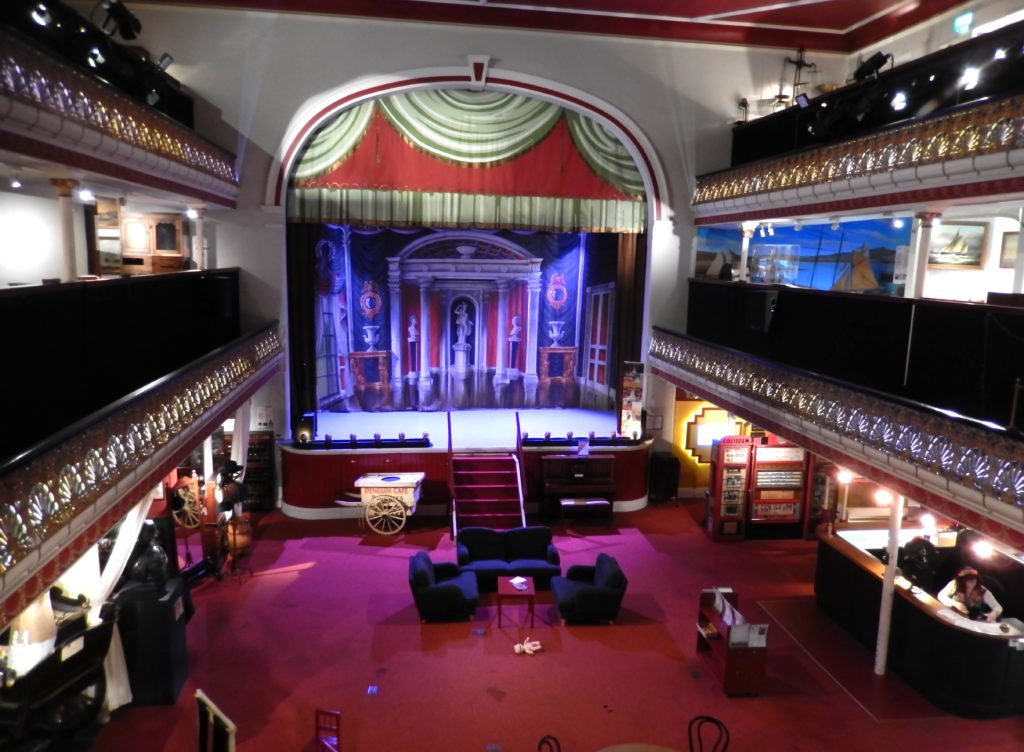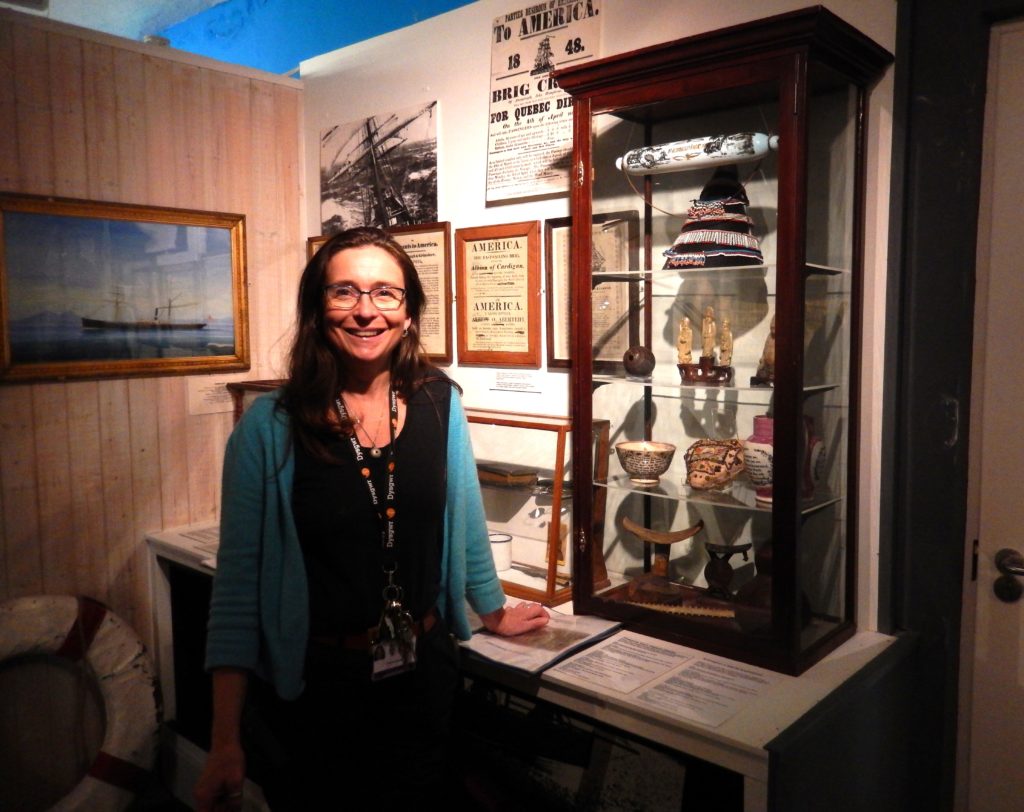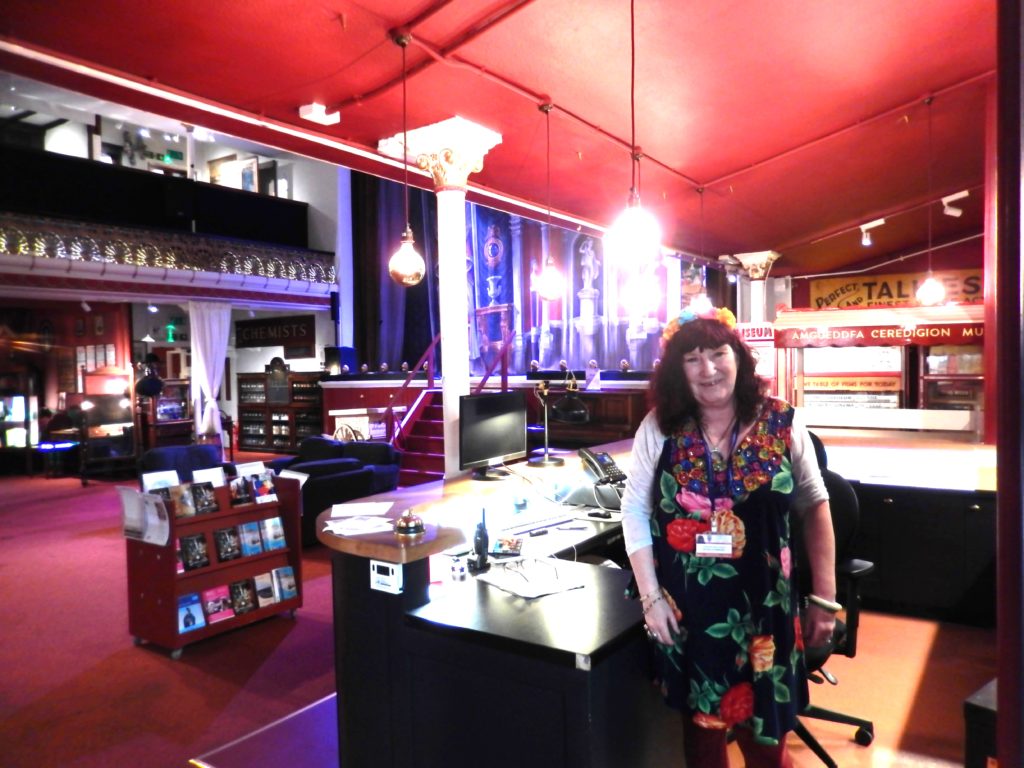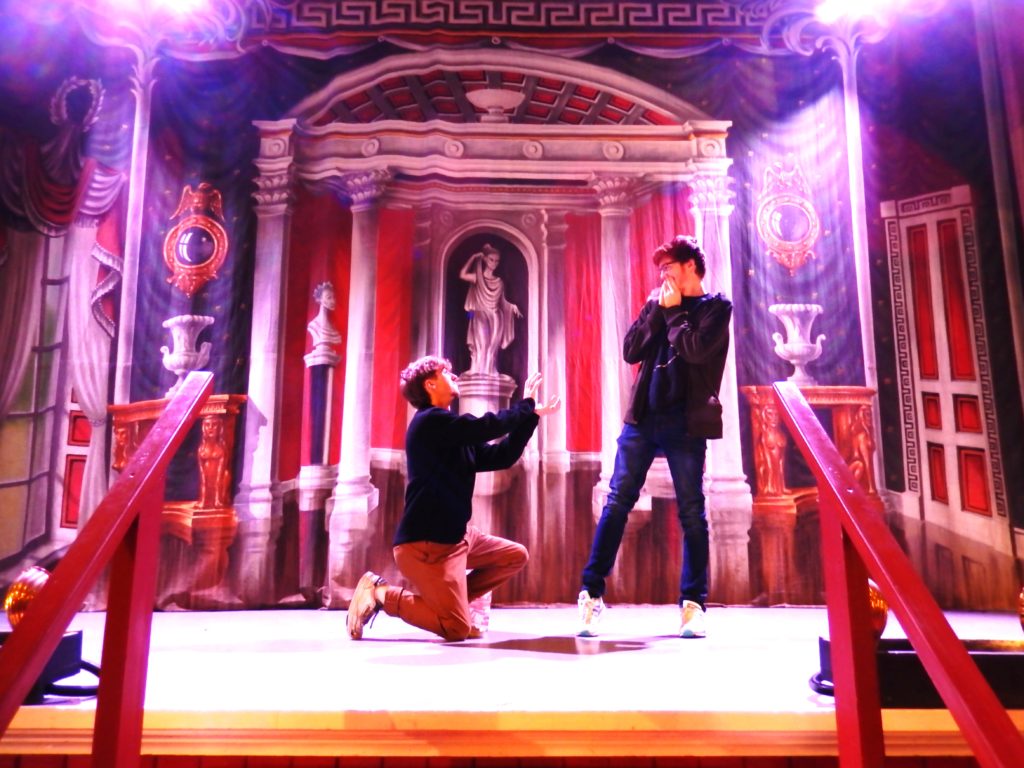Postcard from Amgueddfa Ceredigion Museum

Photo: Julie Brominicks
Julie Brominicks
Roll up, roll up! Come with me, down Ffordd y Môr, attended by herring gulls and a wind from the sea. Wouldn’t you, on this chill autumn day, like to enter a magical world? Come with me. Up a curved sweep of stairs, passing (fear not they are open all day) the Tourist Information Centre, museum gift shop and café, now here, yes, please won’t you step through these doors…Amgueddfa Ceredigion Museum is like no other. Behold the soft spot-lit galleries and stage! The auditorium so warm and inviting! It’s like stepping into a jewellery music box. While adjusting to the ambience you see you are right; the galleries of this former Edwardian theatre are indeed crammed with treasures.

(Photo: Julie Brominicks)
‘Where’s your narrative?’ a museum consultant once asked curator Carrie Canham in despair. But Carrie loves this ‘random, eccentric, surprising Aladdin’s Cave of discovery’ as do I and I’m sure you will too. There is no ‘right route’ around these exhibits.
I find myself undertaking a day-long ascending spiral. The stalls beneath and galleries above are divided into sections. An agricultural corner with ploughs and glowing blacksmith’s hearth. A chemist with curious jars, a dairy with butter pats, and a circa-1850 cottage reconstruction.
{mid-content-banner]
What the butler saw
Exhibits either side of the stage showcase the building’s origins. Stage right is a chaise longue you’re allowed to sit on, and a flickering film about the 1902-32 Coliseum Theatre in a ‘What the Butler Saw’ machine. Volunteer Michelle leaves her dusting to point out photographs of Emmeline Pankhurst who spoke twice here in 1911. ‘It must have been a journey for her back in those days’ she says.

(Photo: Julie Brominicks)
Stage left are seats and sweets in a cabinet that recall the building’s subsequent time as a cinema presided over by Mrs Gale, who dressed like a latter-day Queen Victoria. ‘The last film here was Lady and the Tramp. Many of our more mature visitors say they had their first date here’ Michelle tells me. ‘Visitors are from overseas and local people come who remember some of the farming things and the cinema. Someone came on his 80th birthday and asked if he could have a little dance and sing on the stage.’
The stage remains a big draw. Two visitors I speak to, students Owen and Jai, immediately leap onto the boards and into a pose when I ask for their picture. ‘The stuff here has more impact than in a normal museum’ they say. ‘The theatre gives everything an atmosphere.’

(Photo: Julie Brominicks)
On many an evening, when the reception desk is transformed into a bar, the museum becomes theatre again. Forthcoming performances include The Antique Roadshow’s Marc Allum, the London Chamber Ensemble, and Calan Gaeaf Stories. ‘We love it when it’s full of music and laughter. Events are what the building was designed for and the acoustics are so good’ says curator Carrie.
Kippers
The lively events programme is also a necessary source of income. As a non-statutory service the museum is vulnerable to cuts and nearly half the funding for staff has gone in recent years, while parts of the building are visibly in need of repair. Visitors and volunteers like Michelle are highly valued, as is the local community who for example, participated in workshops to produce carvings for the shop counter. Meanwhile stories from the archives influenced friezes in the café; such as the kippers that during the theatre era, rogue students fried on the balcony gaslights.
Sundial
Carrie’s current favourite artefact is an intricate 17th-century pocket sundial with adjustable latitude for travelling. She’s also fond of the cabinet of objects brought back by seamen. A Yoruba tribe necklace. A soapstone Buddha. A sawfish nose and a cushion stitched by a sailor for his sweetheart.

(Photo: Julie Brominicks)
With its maritime history, Ceredigion’s global connections are crucial. ‘I’m particularly proud of how the museum has become a hub for various communities in the area and we are working hard on representing voices not yet heard in the collection’ says Carrie. ‘Ceredigion has such a diverse community of so many peoples.’
While chatter and baking smells from the café drift up to the galleries, all kinds of folk are looking about the exhibits or relaxing on the sofas. ‘This place has a sense of occasion’ I hear one man say. Two women are laughing at a rotary telephone they remember their grandmother having, and eight-year old Winnie from Aberffrwd is borrowing her Dad’s phone to photograph model ships. ‘I’ve got a boat at home’ she says. ‘It floats!’
Gruesome monkey
Aberystwyth had a famous taxidermist responsible for the cabinets of stuffed animals (which to be fair seem less macabre than the toys; a gruesome monkey with cymbals and a teddy-bear arms akimbo in ghostly embrace). It is while I am reading how poaching became a way of life following legislation that denied poor people the right to kill rabbits and hares thus depriving them of food, that I fully understand why illegal hunting in rural communities still lingers today as an act of defiance.
I have many such moments of comprehension. Museums, particularly this one, with its hotchpotch of interpretation (films, audio, activity sheets and answers to questions secreted by wooden flaps) are good at such consolidation.
This museum has had only three curators. With an interest in Welsh dress, Michael Freeman’s legacy includes a cabinet of Welsh hats described thus: ‘Despite their fragility, over 160 Welsh hats have survived. They are the only type of mid-19th century hat to have survived in these numbers… This is an indication of the importance placed on these hats by those who wore them, those who inherited them and those who now curate them.’ His predecessor Dr Owen had a zest for dentistry, and left some of his teeth on display.
As we have seen, Carrie’s passion is for the people behind the objects and their connections to them, and it shows. Amgueddfa Ceredigion Museum is a magical world, and a welcoming, fun and inclusive one at that.
Support our Nation today
For the price of a cup of coffee a month you can help us create an independent, not-for-profit, national news service for the people of Wales, by the people of Wales.




